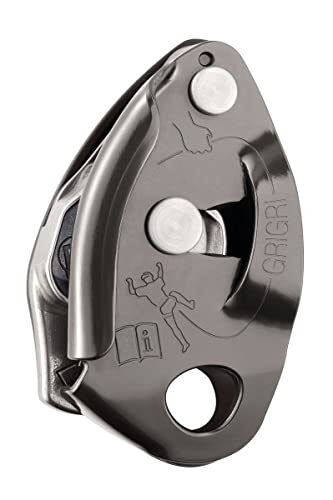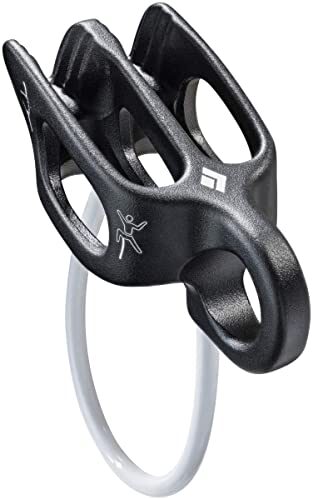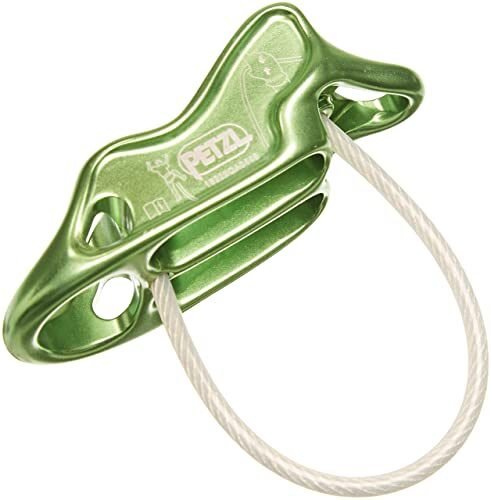Your cart is currently empty!
{ TOP 7 } Best Belay Device – 2020 Reviews
Views: 0
Rock climbing belay devices have grown more complicated and diverse in design over the years since rock climbing first became a sport. Whereas earlier climbers used a simple figure eight device or a sticht plate, now climbers can choose between different types of belay devices with a wide range of safety features and capabilities.
This also means, of course, that climbers have a choice to make when it comes to belay devices. Understanding the difference between different types of belay devices and what type of climbing each belay device is ideal for will help you buy the best belay device.
The tube design is the simplest belay device design. They are so named because they are, in fact, roughly one inch sections of tube — although the design has begun to look less and less so like a tube as the device evolves. Despite these evolutions, the concept of a tube design belay device remains the same — pass a bight of rope through the tube-shaped slot, clip a carabiner through the bight of rope, and let the bend in the rope do the braking.
Tube design belay devices are often referred to simply as ATC’s. Black Diamond created a tube belay device product early in the game and named it the Air Traffic Controller or ATC. That specific product was so popularly used that its name was adopted as the general name for tube design belay devices. Since this early design, many tube design belay devices have evolved to include asymmetric shaping for easier braking. They also almost always now include double tubes — this way, they can be used for repelling which is often necessary in outdoor and multi-pitch climbing situations.
Beyond just asymmetric shaping and dual tube design features, there are also tube design belay devices with auto-locking and anchoring features. These come in handy on multi-pitch routes — the anchoring loop on the inside of the belay device allows a climber to clip into an anchor using a locking carabiner and belay the second climber. The auto-locking features of these types of belay devices have a similar purpose – they make it easier to belay from halfway up the cliff face of a multi-pitch climb.
Overall, tube design belay devices are the genesis of belay devices and the simplest of all modern designs. There are pros and cons to this. The simple design of tube belay devices is perfect for beginner climbers — get the crucial basics of rock climbing down with a solid understanding of how belaying actually works before moving on to devices with more complex mechanisms and designs. Tube design belay devices are also, in almost every case, the lightest and least expensive option for belay devices. Whether you’re just starting out climbing and don’t want to splurge on expensive gear or you’re looking to be as lightweight as possible for that advanced multi-pitch climb, tube design belay devices are the way to go.
However, belay devices with more complex designs are arguably safer in some ways. As will be explained further down, there are plenty of belay device designs that auto-lock more effectively than tube design belay devices are able. There are also plenty of wrong ways to orient some of the more modern tube design belay devices that can make things difficult or even dangers on the wall. So while tube design belay devices are some of the most popular, the most tried and true, and the most common belay devices out there, there’s also a lot to keep in mind before choosing one to climb with.
Assisted Braking (Passive and Active)
For non-beginners, there are more complex belay device designs available to make belaying easier and safer — if used correctly. These are called assisted braking belay devices and there are two general types — passive and active.
Assisted braking devices essentially pinch the climbing rope using a range of mechanisms to catch a fall or take some of the weight off the belayer’s hand strength. Again, they can do this either passively or actively. Passive assisted braking devices are more simple, mechanically, than active assisted braking devices. Passive assisted braking devices require the belayer to pinch the rope between the belay device and a carabiner. They’re lighter and less expensive, but still require a significant amount of hand strength and know-how from the belayer.
Active assisted braking devices do much more of the work for the belayer, pinching the rope using mechanisms inside the belay device itself. Many of these devices can take all of the weight off the belayer’s hand strength during a fall or just the climber taking a break halfway up the route. Just like with the other types of belay devices, active assisted braking belay devices take some practice — arguably the most practice, in fact, as the complicated design of these devices necessitate more complicated handling.
Active assisted braking devices do so much work for the belayer, in fact, that accidents tend to happen — belayers put too much faith in the belay device and pay less attention to proper belaying safety practices. Again, for that reason, belayers should learn how to belay with tube design belay devices before moving on to assisted braking devices. And — as with every belay device — proper safety techniques should be used. Active assisted braking devices are also the most expensive and heaviest of the belay device types.
As described above, the range of belay devices available on the rock climbing market continues to evolve and expand. The type of belay device you need varies depending on your experience level, where you’re climbing, and what type of climbing you plan to do. Below are seven of the top rock climbing belay devices available on Amazon. No matter what you’re looking for, one of these devices is sure to fit your needs.

Just about every serious rock climber you see at the crag or in the gym will have a Petzl GriGri 2 clipped somewhere. It’s heavy and expensive, but the Petzl GriGri 2 has proven time and time again that it’s the best belay device on the market for top rope, sport, multi-pitch climbing — you name it. The Petzl GriGri 2 is an active assisted braking belay device — meaning it’s capable of doing all the work for you (even though you should never intentionally ask it to do so). Mechanisms within the belay device itself will cam the rope’s upward movement in the case of falls or takes. Lowering and paying out slack involve pulling back on a lever and guiding the rope around the curved edge of the device for a smoother glide. Obviously, this belay device does take a little practice to handle correctly — it might not be the best option for beginner climbers just learning how to belay.
The Petzl GriGri 2 does have some drawbacks. It only has one rope slot necessitating an additional tube belay device for rappelling. It’s also one of the heavier options for belay devices weighing in at 175 grams. And while it’s not quite as steep a cost as some of the other assisted braking devices, it is still no drop in the bucket. Again, despite all this, it’s still the top pick for a belay device — almost every climber has a Petzl GriGri.
- Type: Active assisted braking
- Weight: 175 grams
- Rope Size Compatibility: 8.5-11 mm
- Rope slots: 1
- Arguably the safest belay device
- Can only handle one rope necessitating an additional tube belay device
- Heavy
- Expensive

If you’re a bigger fan of unassisted braking, try out the Black Diamond ATC Guide. This tube design belay device only weighs 80 grams, and have a good price (although there are cheaper tube design belay devices available if you’re willing to part with some of the Black Diamond ATC Guide’s additional features). It’s compatible with thinner ropes than the Petzl GriGri 2 — you can use anywhere from a 7.7 to 11 mm rope with the Black Diamond ATC Guide. And its dual rope slots can handle two ropes — perfect for multi-pitch and rappelling.
While the Black Diamond ATC Guide is just a tube design belay device, it does have some of those additional features discussed above that make it a little less like a tube, a little heavier, a little more expensive, and a little more versatile. The Black Diamond ATC Guide has an asymmetric shape — this helps guide the rope smoothly and keep the belay device correctly oriented whether you’re lowering, taking, catching, or paying out slack. It also has an auto-block feature for unexpected falls and an additional anchor loop for belaying a second climber. The major downside to the Black Diamond ATC Guide is mainly its unassisted braking design.
- Type: Tube
- Weight: 80 grams
- Rope Size Compatibility: 7.7-11 mm
- Rope slots: 2
- Dual rope slots
- Great for multi-pitch climbing
- Auto-block feature
- Asymmetric shape
- Lightweight, inexpensive

The Edelrid MegaJul Belay Device is a great option for climbers looking for something a little more sophisticated than a tube design belay device but don’t want all the weight, mechanisms, and cost of an active assisted braking device like the Petzl GriGri. The Edelrid MegaJul belay device is a passive assisted braking device meaning the belayer can pinch the rope between the device and a locking carabiner to stop a fall. This all takes that much stress and weight off of the belayer’s hand strength.
At 65 grams and with its price, the Edelrid MegaJul belay device is moderately priced and lightweight — which is appropriate considering it is essentially the moderate option between a tube design and active assisted braking design on the sophistication scale of belay devices. It’s compatible with ropes from 7.8 to 10.5 mm and has two rope slots making it perfect for multi-pitch climbing. It also offers much easier slack payout than assisted braking devices do. This belay device also comes with auto-block and anchor capabilities. The only notable downside of the Edelrid MegaJul is the complexity — you can tell just by looking at the device that it’s not your average tube design belay device and it takes that much more practice to be able to handle it correctly.
- Type: Passive Assisted Braking
- Weight: 65 grams
- Rope Size Compatibility: 7.8-10.5 mm
- Rope slots: 2
- Great for lead climbing, easy slack payout
- Designed for multi-pitch climbing with auto-block and anchor capabilities
- Lightweight
- More complex than tube belay devices without the benefits of active assisted braking

The Black Diamond ATC device is about as simple as it gets for modern belay devices — making it perfect for beginner belayers to really learn how to belay and understand the physics behind belaying. This is important to nail down before progressing on to belay devices that might do a lot of the work for you — if you don’t understand how your gear works, you won’t truly understand how to safely and correctly use it. The Black Diamond ATC weighs in at 65 grams and will just cost a little making it by far the cheapest belay device on this list. It’s compatible with ropes from 7.7 to 11 mm and has two rope slots for rappelling. And, it’s just as lightweight as the Edelrid MegaJul without the extra cost.
One of its greatest advantages is also its most significant drawback, however. The simple design means there’s no assisted braking and no anchoring features — while the Black Diamond ATC is a great little device to have on hand, you’ll likely need to supplement it with additional belay devices once you progress from a beginner belayer to more advanced climbing like multi-pitch.
- Type: Tube
- Weight: 65 grams
- Rope Size Compatibility: 7.7-11 mm
- Rope slots: 2
- Simple design perfect for learning the basic mechanics of belaying
- Dual rope slot for belaying
- Inexpensive
- Unassisted breaking
- No anchoring features

If you’re trying to carry as little weight with you as possible to the crag or up the cliff face, the Petzl Reverso might be the right option for you. At just 56 grams this is the most lightweight belay device available on the market that certainly doesn’t sacrifice anywhere else in its design or functionality to hit that minimal weight.
It will cost you a little more than your average tube design belay device — but the lightweight design and other additional features might be exactly what you’re looking for for just a little additional dough. In fact, the Petzl Reverso has all the same features as the Black Diamond ATC Guide for the same price — and less the weight.
The Petzl Reverso does have a problem with thicker climbing ropes — to play it safe, it’s suggested that only ropes from 6.9 to 9.5 mm thickness are used with this belay device. But it does have two rope slots for rappelling. The aluminum material used to make this device has also been known to be slightly less durable and wear more significantly with use than some of the more heavy duty belay devices. Keep all this in mind — this is the lightest weight belay device out there, but how badly do you really need to shave off those extra 9 grams?
- Type: Tube
- Weight: 56 grams
- Rope Size Compatibility: 6.9-9.5 mm
- Rope slots: 2
- Ultra lightweight
- Same price as Black Diamond ATC Guide with less weight
- Aluminum known to be less durable
- Doesn’t perform as well with ropes over 9.5 mm

The Camp USA Matik belay device is arguably the safest belay device on the market. This device goes beyond just active assisted braking and includes an anti-panic braking system unique to the Camp USA Matik — no other belay device on the market has quite the same mechanisms as the Camp USA Matik. Again, however, this shouldn’t be mistaken for a self-belaying gadget. It’s still crucial that proper belay technique is used, and this device might not be the best option for beginner climbers who are still working on developing strong belay techniques.
Additionally, you’re certainly paying for your safety. The Camp USA Matik belay device has higher price tag — making it the most expensive belay device on this list. It’s steep for a belay device — another reason why it might not be the right option for beginner belayers. The Camp USA Matik is also the most expensive belay device on this list — by a lot. This hunk of gear weighs in at 275 grams. If you’re working towards a lightweight ascent, the Camp USA Matik might not be the option for you. It also only accommodates one rope. However, it is better for lefties.
- Type: Active Assisted Braking
- Weight: 275 grams
- Rope Size Compatibility: 8.6-10.2 mm
- Rope slots: 1
- Anti-panic braking system
- Better for lefties
- Extremely heavy
- Most expensive
- Single rope only

Looking to stay on the forward edge of rock climbing technology? Try out the Climbing Technology Click Up belay device. This is a passive assisted braking device that claims to be error proof. Even if you load the ropes in inverted, the assisted braking mechanisms will still work.
This is the most expensive passive assisted braking device, and it’s also the most expensive of these types of belay devices so it might not be the right move for your primary belay device, but if you’re interested in trying out new tech, this is the up and coming design for belay devices — whether it ultimately fails or not is yet to be seen. It’s not ideal for lead climbing as slack payout proves difficult.
- Type: Passive Assisted Braking
- Weight: 122 grams
- Rope Size Compatibility: 8.6-10.5 mm
- Rope slots: 1
- Still safe if ropes loaded inverted
- “Error-proof”
- Not ideal for lead climbing
- Most expensive passive assisted braking
Being confident and comfortable with your chosen belay device is crucial for rock climbing safety, but picking the right belay device can be just as important. This guide offers the top options for all levels and types of climbers so no matter where, what, or how you’re climbing, you can find the best belay device to fit your needs.